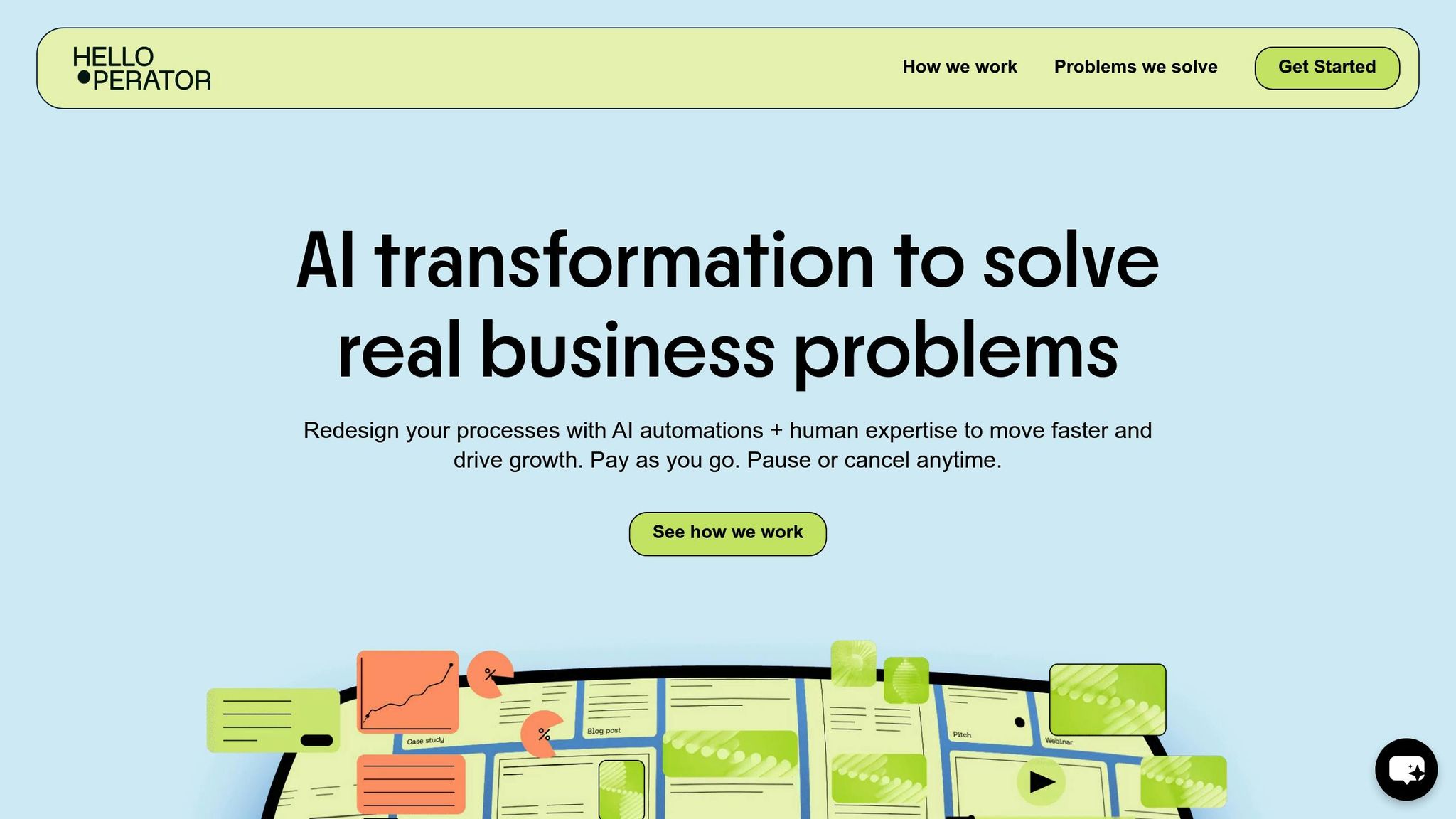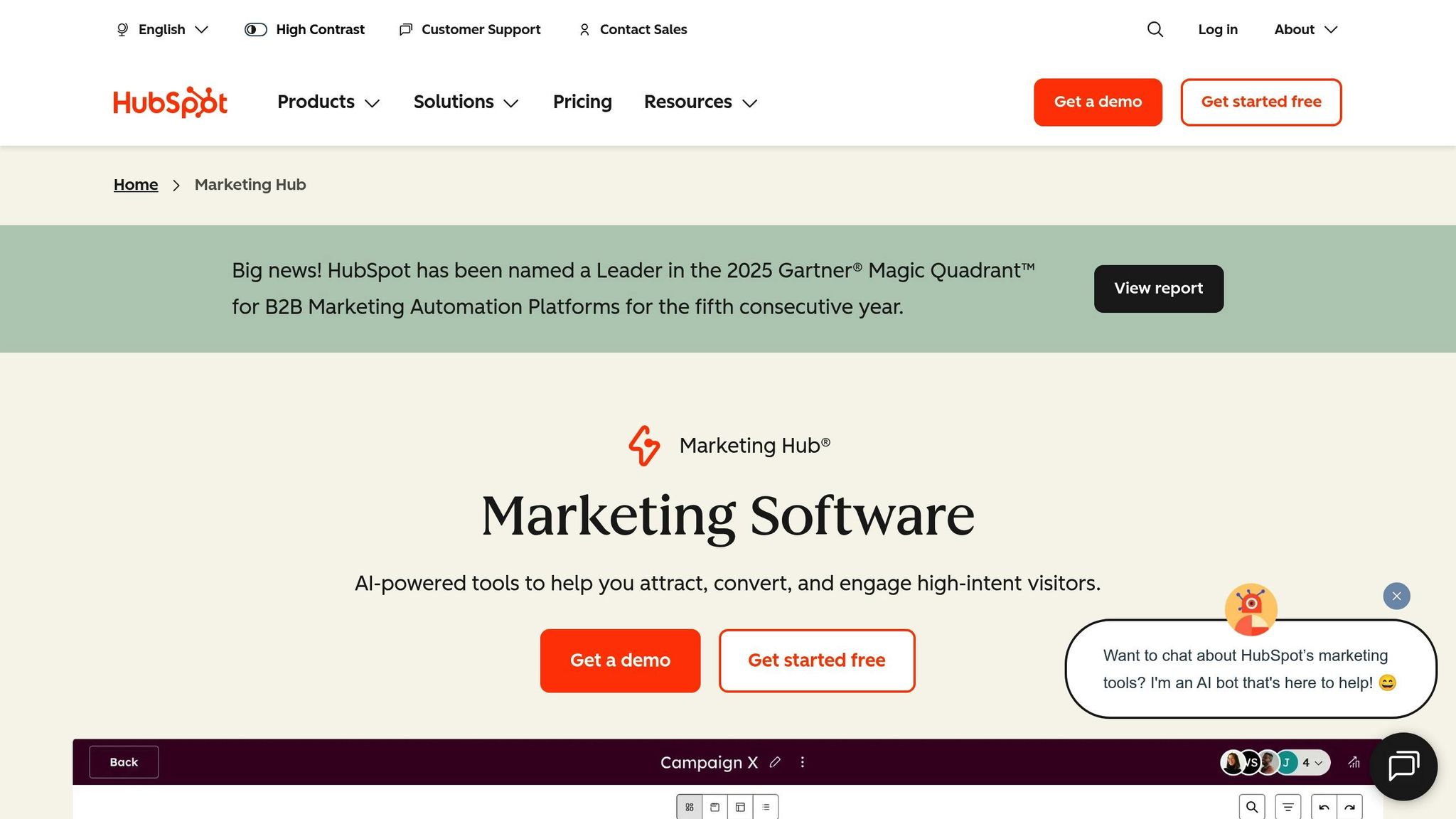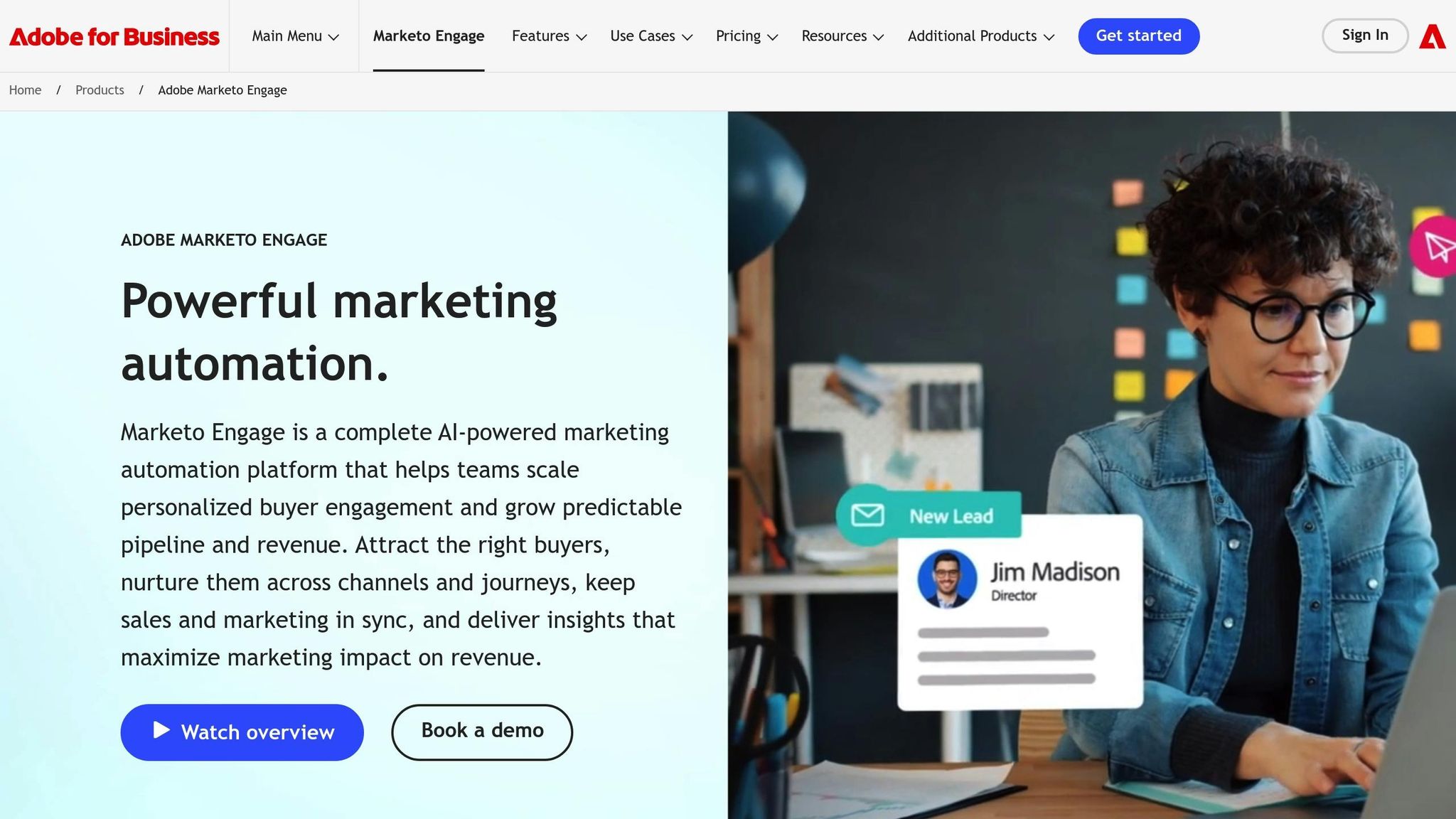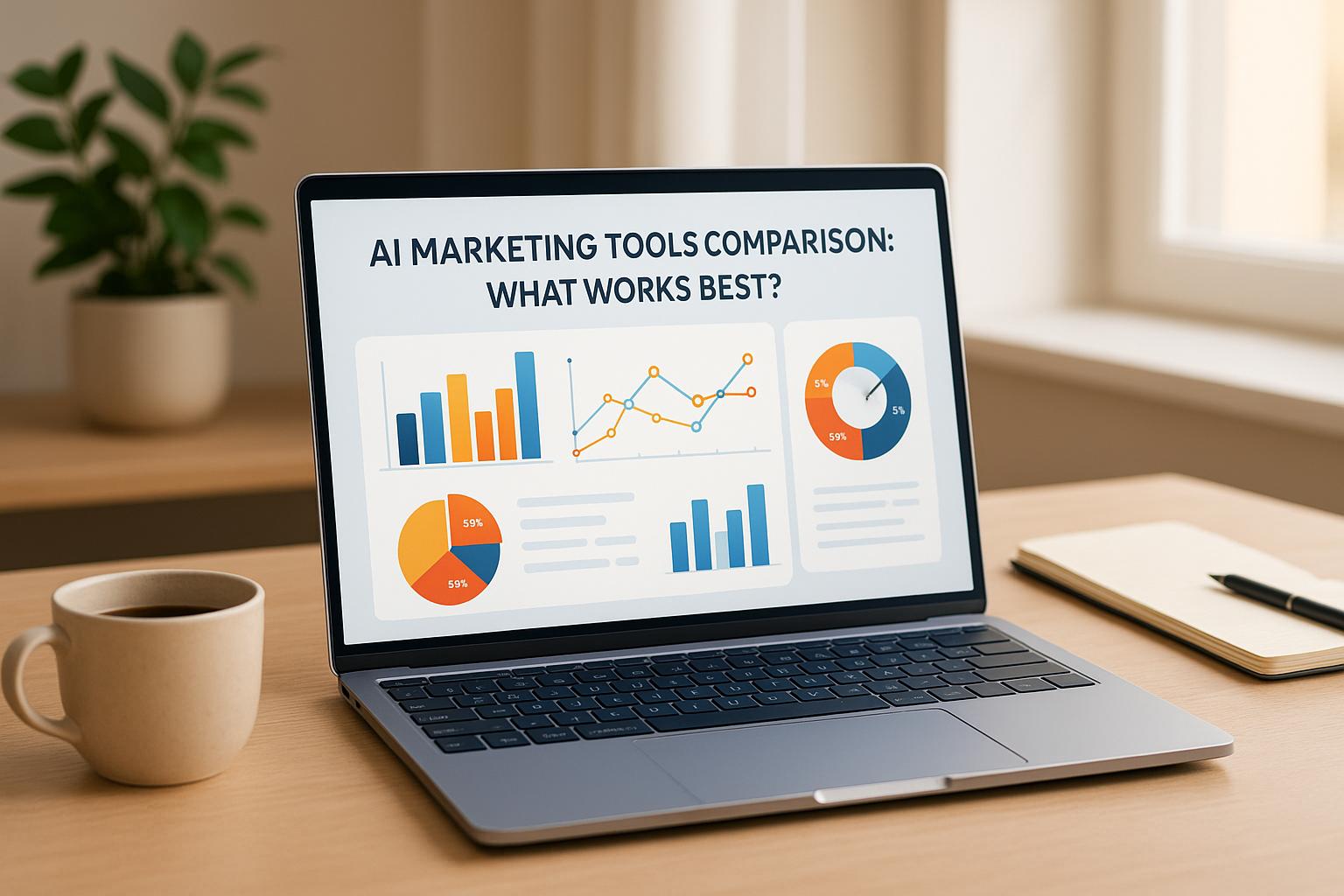AI marketing tools are transforming how businesses operate, with 72% of global companies using artificial intelligence by 2024. These tools help automate tasks, personalize customer experiences, and predict behaviors, making marketing more efficient and effective. But which platform works best for your needs? Here's a quick breakdown:
Key Takeaways:
- Hello Operator: Focuses on human-AI collaboration with custom solutions and Slack integration. Plans start at $3,750/month.
- HubSpot Marketing Hub: Offers all-in-one automation for growing businesses, starting at $15/month. Scales with advanced features.
- Marketo Engage: Designed for complex B2B scenarios with advanced personalization and integrations. Pricing is custom and database-dependent.
Quick Comparison:
| Tool | Best For | Starting Price | Strengths | Limitations |
|---|---|---|---|---|
| Hello Operator | Teams needing AI expertise | $3,750/month | Human-AI collaboration, custom solutions | Higher cost, requires collaboration |
| HubSpot | Growing businesses | $15/month | User-friendly, CRM integration | Costs rise with contacts and features |
| Marketo Engage | Large B2B organizations | Custom pricing | Advanced automation, personalization | High setup costs, learning curve |
Each tool has unique features tailored to different business needs. Small businesses might prefer HubSpot’s affordability, while enterprises benefit from Marketo’s advanced capabilities. For those seeking expert support, Hello Operator offers a collaborative approach. Dive into the full article for deeper insights into pricing, features, and use cases.
+13 Best AI Marketing Tools in 2025 (Ranked by Categories & Use Cases)
1. Hello Operator

Hello Operator takes a human-AI collaboration approach to elevate your AI-driven marketing strategy. Instead of replacing marketing teams, the platform integrates on-demand AI marketing specialists directly into your Slack workspace. These specialists handle repetitive tasks while ensuring human oversight remains central to every process. Let’s dive into Hello Operator’s standout automation features that boost efficiency.
Automation Capabilities
Hello Operator uses a "Done-With-You" methodology to automate time-consuming marketing tasks while keeping your team in control. The platform offers custom AI solutions that connect seamlessly with your data systems, such as real-time SEO dashboards, competitor trackers, and automated content publishing tools.
Some examples of its capabilities include:
- SEO Content Publishing Engine: Automatically generates and schedules optimized blog and social media posts.
- LinkedIn Scraper: Identifies high-quality prospects based on your ideal customer profile.
- Competitor Tracker Bots: Monitors pricing changes and marketing campaigns in real time.
By taking on the heavy lifting - like data collection, initial content drafts, and routine monitoring - Hello Operator frees up your marketing team to focus on strategy. These tools are designed to integrate smoothly into your current workflows, making it easier to adopt AI without disrupting your processes.
Integration with Tech Stacks
What sets Hello Operator apart is how effortlessly it fits into your existing tech stack. Whether it’s your CRM, analytics platforms, or content management systems, Hello Operator works within the tools you already use. There’s no need for a complete overhaul - just seamless integration.
The platform primarily operates through Slack, allowing AI specialists to become part of your daily workflow. You can request tasks, get updates, and collaborate on projects without having to learn new software. This approach minimizes the learning curve and keeps your team productive.
Custom AI applications are built to work with your proprietary data, such as customer databases, sales records, and marketing performance metrics. This ensures AI-driven insights and automation are tailored specifically to your business, rather than relying on generic industry data.
Pricing
Hello Operator offers three flexible pricing options to meet various business needs:
- Ongoing & On-Demand Plan: Starting at $3,750 per month, this plan provides access to a full-stack AI marketing team, custom GPTs and AI agents, human-AI content systems, and advanced SEO tools.
- Project-Based Plan: At $5,950 per month, this option is ideal for businesses looking to automate specific workflows or develop custom AI applications. It includes strategic planning, AI app development, and dedicated project management.
- Workshops & Training: Custom pricing is available for hands-on sessions designed to help your team build internal AI expertise. These workshops focus on practical solutions tailored to your unique marketing goals.
All plans are contract-free, giving you the flexibility to scale your AI marketing efforts as your needs evolve.
2. HubSpot Marketing Hub

HubSpot Marketing Hub combines traditional marketing automation with AI-driven tools, holding a 38.27% market share and earning recognition as a Leader in the 2025 Gartner Magic Quadrant for B2B Marketing Automation Platforms. It offers three pricing tiers, each tailored to meet different business sizes and budgets.
Automation Capabilities
HubSpot shines in automation, streamlining marketing efforts across multiple channels through centralized workflows. These workflows support lead nurturing, email campaigns, and multi-step marketing strategies. The Professional tier introduces more advanced workflows, while the Enterprise tier takes it further with custom event triggers and processes.
Email marketing automation is a standout feature. The Starter plan offers basic autoresponders, while the Professional and Enterprise tiers include advanced tools like A/B testing, smart content, and personalized email experiences powered by custom data. Automated follow-ups ensure leads stay engaged and don't slip through the cracks.
AI enhances lead scoring and lifecycle management, creating more accurate scoring models. Features like "contains" filters allow for detailed lead qualification, and higher-tier plans combine contact and company scores for a well-rounded view of prospect quality.
On the social media front, HubSpot offers AI-suggested quick replies for social comments and messages, a Hashtag Bank to maintain consistency, and automatic AI-generated video captions for platforms like YouTube and X (formerly Twitter).
Workflows also help businesses standardize CRM data and send notifications via email, text, in-app messages, Slack, or Microsoft Teams. This comprehensive approach addresses the rising demand for automation, with 91% of company decision-makers reporting increased automation requests from their teams.
These automation tools set the stage for HubSpot's advanced personalization capabilities.
Personalization Features
HubSpot excels at creating tailored customer experiences. Its personalization engine blends rule-based logic with AI to deliver dynamic content at scale. Smart content tools automatically adjust website headers, calls-to-action, and product recommendations based on visitor behavior and characteristics. Personalization tokens can insert details like contact names or company information into emails, website content, or SMS messages. When paired with behavioral tracking, marketers can reference past purchases, engagement history, or demographic data.
Progressive profiling is another useful feature, allowing businesses to gather more customer data over time without overwhelming users with lengthy forms. This approach builds detailed customer profiles while keeping the user experience smooth.
Studies show that personalized marketing strengthens audience connections and boosts engagement compared to generic campaigns.
Integration with Tech Stacks
One of HubSpot's strengths is its ability to integrate seamlessly with other tools, addressing a common challenge in marketing technology. Its App Marketplace provides hundreds of native integrations, connecting with tools like Gmail, Google Calendar, Outlook, and Zapier to extend its capabilities.
For businesses with unique needs, custom API integrations allow full control over data flow. Tom Ryan, Founder & CEO of MarCloud, highlights the strategic importance of these integrations:
"Integrating HubSpot Marketing Hub with the rest of your tech stack isn't a backend task for IT. It's a strategic move with direct consequences for how effectively your team can prove marketing ROI, secure future budget, and run campaigns without technical roadblocks."
Thanks to its shared CRM foundation, HubSpot ensures seamless data flow between its Marketing, Sales, Service, CMS, and Operations Hubs, providing a unified customer view and eliminating data silos.
Pricing
HubSpot Marketing Hub's tiered pricing structure accommodates businesses of all sizes, with costs scaling based on contact volume.
| Tier | Starting Price | Contact Limit | Key Features |
|---|---|---|---|
| Starter | $15/month | 1,000 contacts | Basic email automation, forms, landing pages |
| Professional | $800/month | 2,000 contacts | Full workflow automation, A/B testing, smart content |
| Enterprise | $3,600/month | 10,000 contacts | Custom event triggers, advanced workflows, adaptive testing |
Additional costs include onboarding fees, which range from $3,000 for Professional plans to $6,000 or more for Enterprise plans. Contact volume pricing adds $20/month per 1,000 contacts for Starter, $45/month per 5,000 contacts for Professional, and custom pricing for Enterprise. Reports show that businesses using Marketing Hub see an average of 114% more web traffic and 129% more leads within a year.
"If marketing had a Swiss Army knife, it would probably look a lot like HubSpot."
- Chris Onyett, Managing Partner, Roketto
sbb-itb-daf5303
3. Marketo Engage

Adobe Marketo Engage stands out as a powerful AI-driven tool designed for marketing teams tackling complex B2B scenarios. It’s a marketing automation platform built to handle sophisticated campaigns and deliver personalized customer experiences, making it a go-to for businesses that need detailed customer journey mapping and advanced automation.
Automation Capabilities
At the heart of Marketo Engage’s automation is its Smart Campaigns system, which uses both batch and trigger campaigns to respond to customer actions. With its intuitive visual workflow builder, marketers can create multi-step campaigns across various channels - no coding required.
The platform shines in lead management. It captures and continuously updates customer profiles at both the lead and account levels. Its robust lead scoring system prioritizes engaged prospects, while automated lead routing ensures qualified leads are sent to the right sales team members. Lead scores and field values are updated automatically based on customer interactions, keeping everything up to date.
Marketers can also use self-service flow steps to perform tasks like data enrichment, sending alerts, calculations, and even merging duplicate entries. Integration with tools like Workfront, AEM Assets, and Fusion makes content management more efficient, simplifying tasks like managing versions, localizations, and variations through smart campaigns or tokens.
The platform’s automation capabilities have delivered tangible results. For instance, businesses using Marketo Engage have reported a 37% reduction in time spent on email campaigns, a 400% decrease in campaign costs per prospect, and a 40% improvement in lead quality and scoring.
Personalization Features
Marketo Engage takes personalization to the next level by combining rule-based logic with AI to create dynamic, tailored content experiences. It builds detailed audience segments by continuously enriching customer profiles with data from custom objects, fields, and activities.
With token-based personalization, marketers can easily insert variables like customer names or lead scores into emails and landing pages. The platform also uses AI-driven predictive content to automatically select and insert the content most likely to convert, based on historical data and individual behavior. Dynamic content blocks adjust in real time to reflect customer behavior and audience segments, supporting both lead generation and account-based marketing strategies.
Adobe Sensei GenAI enhances these capabilities further, powering smarter chatbots and predictive content to create dynamic customer journeys. Integration with Adobe Express and Adobe Firefly makes it easier to produce personalized, high-quality images and assets. Additionally, Account-Based Marketing (ABM) features like Target Account Management (TAM) and dynamic Smart Lists help marketers focus on high-value accounts. AI-powered predictive audiences even forecast potential unsubscribes, enabling proactive campaign adjustments.
Integration with Tech Stacks
Marketo Engage integrates seamlessly with a wide range of tools, offering both native and pre-built connections to popular CRMs, data platforms, content management systems, and sales engagement tools. Its bi-directional CRM integrations with Salesforce, Microsoft Dynamics, and Veeva can sync up to 200,000 records per hour and 2 million records per day. Marketers can monitor sync rates and address issues quickly using self-service dashboards, which also provide access to best practice documentation.
Within the Adobe Experience Cloud ecosystem, Marketo Engage connects with tools like Adobe Real-Time CDP, Journey Optimizer B2B Edition, Workfront, and Experience Manager Assets. This creates a unified marketing stack where tools share data and context, enhancing overall efficiency.
For advanced needs, the platform offers Data Streams (available in Prime and Ultimate packages), which provide near real-time lead activity and user audit data without impacting API quotas. These streams integrate with business intelligence tools like Power BI, Tableau, and Domo. Developers can also leverage the platform’s robust REST API and webhooks for custom integrations.
New content integrations, such as the AEM Assets Live Link Connector and Adobe Express, streamline workflows and ensure brand consistency across campaigns.
Pricing
Marketo Engage offers four pricing tiers: Growth, Select, Prime, and Ultimate. Each plan includes unique features like predictive content, interactive webinars, and advanced analytics, with varying API call limits. However, Adobe doesn’t disclose specific pricing publicly - businesses need to contact the sales team for a custom quote.
Pricing is based on the number of contacts in the database, which could pose challenges for rapidly growing companies. Certain features, like Data Streams, are currently exclusive to Ultimate plans, with availability for Prime customers expected in 2025. Additionally, third-party tools like Litmus and SpamAssassin require separate subscriptions, and full Adobe Express capabilities - including GenAI features - necessitate an Express Enterprise license.
While the platform requires a significant upfront investment in setup, training, and integration, the results can be impressive. Businesses that fully leverage Marketo Engage report an increase in revenue by 2.8x and pipeline growth by 24x.
Benefits and Drawbacks
Let’s dive into the pros and cons of each tool and how they stack up against different business needs. This breakdown will help you decide which solution aligns with your goals.
Hello Operator stands out for its blend of human expertise and AI-driven solutions. It offers on-demand marketing specialists, custom AI capabilities, and flexible month-to-month contracts starting at $3,750. This makes it ideal for businesses wanting AI expertise without committing to full-time hires. However, the higher cost may be a hurdle for smaller businesses, and its collaborative service model means it’s not a standalone tool.
HubSpot Marketing Hub impresses with its wide-ranging automation features. From lead scoring and email management to social media oversight, it integrates seamlessly with its CRM. The intuitive interface is a big plus for teams lacking technical expertise. That said, its vast feature set can overwhelm smaller teams, and costs can climb as you add contacts or advanced functions.
Marketo Engage is geared toward B2B marketing, offering advanced personalization and robust integrations for enterprise-level operations. While powerful, it comes with steep setup and training costs. Its database-based pricing can also get expensive for fast-growing companies, and the platform has a learning curve.
| Tool | Key Strengths | Main Limitations | Best For |
|---|---|---|---|
| Hello Operator | Human-AI collaboration, custom solutions, flexible contracts, project management | Higher cost ($3,750+/month), requires collaboration, not a standalone tool | Teams seeking AI expertise without full-time hires |
| HubSpot Marketing Hub | Comprehensive automation, easy-to-use, strong CRM integration, scalable features | Can overwhelm smaller teams, rising costs with contacts and complexity | Growing businesses needing all-in-one automation |
| Marketo Engage | Advanced B2B automation, powerful personalization, enterprise integrations | High setup costs, complex implementation, database-based pricing, learning curve | Large B2B organizations with complex marketing needs |
Key Trends in AI Marketing
Certain trends are shaping how businesses approach AI in marketing:
- Automation: AI can handle repetitive tasks and optimize campaigns in real time, delivering performance gains of 15–25%.
- Personalization: AI excels at tailoring customer experiences, with 88% of marketers saying it helps customize journeys across multiple channels. By analyzing behavior patterns, AI delivers personalized content at a scale that’s impossible manually.
But it’s not all smooth sailing. Challenges like data privacy remain significant, with 40% of marketers citing it as the biggest barrier to AI adoption. The stakes are high - data breaches cost an average of $4.24 million in 2022.
Another concern is content quality. About 40% of marketers report that AI outputs can feel "robotic", and only 4% of B2B marketers fully trust AI-generated content. This highlights the ongoing need for human oversight.
Implementation complexity is also a hurdle. Many businesses struggle with integrating tools, training teams, and understanding AI’s "black box" decision-making.
Costs to Consider
AI marketing tools come with a wide range of pricing options. Entry-level plans typically run between $20 and $200 per month, while enterprise solutions can exceed $20,000 per month. On top of that, setup costs can range from $500 to $10,000, and training costs for teams may add another $1,000 to $5,000.
The most successful implementations strike a balance - leveraging AI’s efficiency while keeping human oversight to guide strategy and execution. This balance ensures that businesses can harness AI’s power without losing control of their marketing vision.
Final Recommendations
When selecting an AI marketing tool, it's crucial to match it with your business's size, budget, and specific needs. Here's a breakdown tailored to U.S. businesses, based on our analysis:
For small businesses with limited budgets (under $500/month), look for tools that are affordable, easy to use, and deliver quick results without straining your resources. As Bernard Marr from Forbes explains:
"The AI revolution isn't just for large companies with big budgets. Small business owners who embrace these tools today will find themselves better positioned to compete, scale, and thrive in an increasingly digital marketplace."
For mid-sized businesses ($500–$5,000/month budget), HubSpot Marketing Hub is a standout choice. Starting at $50/month, it offers a full suite of automation features and integrates seamlessly with its CRM. This makes it an excellent solution for growing companies that need a user-friendly, all-in-one platform with pricing that scales as your business grows.
For teams needing dedicated AI expertise, Hello Operator is a strong option, starting at $3,750/month. It specializes in a collaborative human-AI approach, offering custom AI capabilities, dedicated project management, and flexible month-to-month contracts. This makes it ideal for businesses that want expert support without committing to long-term hires.
When making your decision, prioritize tools that offer integration, scalability, and ease of use. It's worth noting that 40% of small U.S. businesses are already using generative AI, up from 23% in 2023, and 91% believe it will drive future growth.
Take advantage of free trials to test how well a tool addresses your specific challenges, whether it's content creation, lead nurturing, or automating workflows. Start by solving your biggest marketing pain points and expand your toolkit as you see measurable results.
The key to success lies in balancing AI's efficiency with human oversight. This ensures that while automation handles repetitive tasks and provides data-driven insights, you stay in control of your overall marketing strategy.
FAQs
How can I choose the right AI marketing tool for my business?
When selecting an AI marketing tool, the first step is to pinpoint your business's specific goals. Are you looking to automate repetitive tasks, tailor customer experiences, or gain deeper insights through data analysis? Understanding your priorities will help you focus on tools that address those needs effectively.
Next, assess each tool's features to see how well they align with your objectives and whether they can deliver tangible results. Pay attention to tools that have a proven history in your industry - case studies and testimonials can provide valuable insight into their performance. Look for evidence of benefits like improved efficiency or a boost in ROI.
Before making a final decision, consider running a pilot program. This allows you to test the tool's compatibility with your current systems and evaluate its performance in a real-world setting. It’s a practical way to ensure the tool meets your expectations before fully committing.
What challenges and costs should I consider when adopting AI marketing tools?
Adopting AI marketing tools isn't without its hurdles and expenses. Some of the most common challenges include ensuring the availability of high-quality data, addressing ethical concerns, meeting regulatory standards, and managing potential biases in AI systems. Successfully overcoming these issues often requires thoughtful planning and strategic adjustments.
The financial commitment can vary widely based on the scale of the project. For smaller-scale initiatives, costs might begin around $10,000, while large enterprise-level implementations can soar past $10 million. Additional expenses often include upgrading infrastructure, ongoing maintenance, training staff, and implementing strong data security and privacy protocols. Integrating these tools with existing systems can also add layers of complexity and influence the overall budget. Carefully considering these factors is crucial for a smooth and cost-efficient implementation process.
How do AI marketing tools improve personalization and boost customer engagement?
AI marketing tools leverage machine learning and data analysis to craft deeply personalized customer experiences. By studying user behavior and preferences, these tools can fine-tune messages, recommendations, and content to suit each individual, making interactions feel more relevant and engaging.
For instance, AI can streamline tasks like sending tailored emails, suggesting products, or delivering targeted ads. This ensures customers receive content that aligns with their interests, strengthening connections, boosting engagement, and ultimately driving more conversions by making every interaction feel personal and purposeful.



